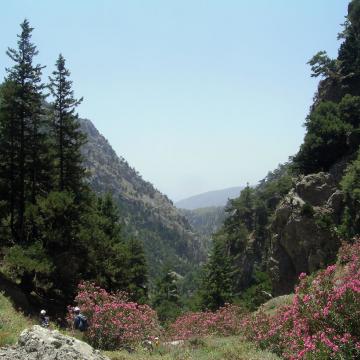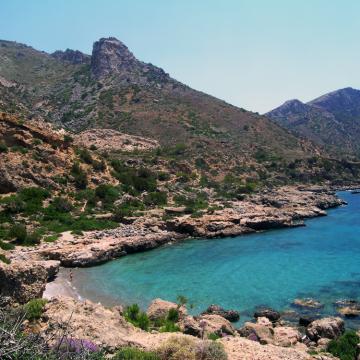GR4340015 - PARALIA APO CHRYSOSKALITISSA MECHRI AKROTIRIO KRIOS
Map
Quality
The island of Elafonisos and the opposite Cretan coast are separated by a relatively narrow zone of shallow waters over permanently submerged sandy sediments of the sea-floor. This combination along with the sand dunes that exist in the island constitute a very important and unique geological formation. Needless to say that apart from the natural beauty, the ecological value of the landscape is considerable since rare bio-communities constitute part of the above mentioned sanddunes; a formation which becomes rearer due to sand removal and the building of hotel complexes. The site is also characterised by a variety of habitat types, most of them fairly well conserved (typical ammophilous and halophytic flora, dune juniper thickets, Juniperus oxycedrus and J. phoenicea arborescent matorrals, Oleoceratonion tall scrub communities, calcareous cliffs; one of the most diverse and endemic-rich groups of communities). The flora of the site is rich in common species and also contains endemics, local endemics and species with geographical distribution of residual character. It is one of only 100 or less sites in the European Community where the plants Androcymbium rechingeri and Ipomoea stolonifera still exist. Endemic subspecies (Felis silvestris cretensis, Meles meles arcalus and Podarcis erhardii elaphonisii) constitute part of the fauna of the site. The area is also very important for migratory birds both as a resting and as a breeding place.The quality of the site lies on social and cultural reasons as well because on its historical associations (in 1824, at Easter Day, Ibrahim pasha killed 850 women and children who had taken refuge in the island; here also there is the grave of the drowned at the shipreck of Imperatrice in 1907) and the archaeological site in the island (Apollo's sanctuary). Finally, one should not fail to mention that the site, being of great aesthetic value, can be used as a holiday-recreation area.OTHER IMPORTANT SPECIES WITH MOTIVATION DBirds: Larus argentatus is referred in annex II2 of the Directive 79/409/EEC.Amphibians: Bufo viridis is referred in annex IV of the Council Directive 92/43/EEC and is protected by the Greek Presidential Decree 67/1981.Reptiles: Coluber gemonensis and Hemidactylus turcicus are protected by the Greek Presidential Decree 67/1981. Lacerta trilineata polylepidota and Telescopus fallax are referred in annex IV of the Council Directive 92/43/EEC and are protected by the Greek Presidential Decree 67/1981.Plants: Silene succulenta ssp. succulenta is a subspecies whose Greek populations exist exclusively in Crete. Ipomoea stolonifera (Ipomoea imperati) and Centaurea pumilio are considered vulnerable in Greece and Europe (IUCN Red Data List) and are included in the checklist of threatened plants in the CORINE biotopes manual. Furthermore they are protected by the Greek Presidential Decree 67/1981. Viola scorpiuroides is considered rare in Greece and Europe (IUCN Red Data List) and is protected by the Greek Presidential Decree 67/1981. Pancratium maritimum is widely distributed in the Mediterranean but most of its populations are characterised by a decreasing trend due to human intervention on its biotopes. Bellevalia brevipedicellata is considered threatened in Greece, Europe and the world (IUCN Red Data List) and is protected by the Greek Presidential Decree 67/1981. Campanula saxatilis and Nigella stricta are considered rare in Greece, Europe and the world (IUCN Red Data List) and are protected by the Greek Presidential Decree 67/1981. Lygeum spartum belongs to the desert-like floristic element, occurring only in steppe communities in Kriti in Greece (it occurs at similar habitats in Spain, Sardinia, Sicily, Italy in Europe); it is one of the very rare grasses in Greece (Damanakis & Scholz, 1990). Distribution in Europe: at similar habitats.
Other characteristics
The island of Elafonisos is located at the south-western corner of Crete. It is separated from the opposite coast by a shallow strait about 150 m in width. The island is oblong with a maximum length of 1500 m and a maximum width of 500 m although for the most part Elafonisos has a width of 150-300 m. The maximum altitude (39 m) is observed at the rocky western part while the rest of the area is principally a sandy lowland. Rocks and cliffs are found only on the periphery, along the coastline (with the exception of the eastern corner of the island). The extended beach of Elafonisos is characterised by the dominance of sanddunes with the well developed community Ammophiletum arenariae. A significant population of Pancratium maritimum (sea-lily) is found in this zone. Thickets of Juniperus oxycedrus ssp. macrocarpa, also on maritime sands, occupy the area behind the Ammophiletum community. Other species met in this scrub zone are: Anthyllis hermanniae, Silene sedoides, Lotus creticus ssp. cytisoides, Ipomoea stolonifera, Orobanche versicolor, Plantago squarrosa. On the rocky coasts that exist in certain parts of the island the following plants grow: Atriplex halimus, Crithmum maritimum, Inula crithmoides, Capparis orientalis, Euphorbia dendroides, Ficus carica. Finally, the central part of Elafonisos is occupied by phrygana (dwarf shrubs) with the following species predominating: Coridothymus capitatus, Phagnalon graecum, Ballota pseudodictamnus, Hyparrhenia hirta, Ruta chalepensis.Similar communities to the ones mentioned above are found on the opposite Cretan coast as well. The monastery of Chrysoskalitissa is located few kilometres prior to Elafonisos island with its surrounding area covered by characteristic phryganic vegetation intermixed with maquis, garigue and other scrubs. The following species predominate: Erica manipuliflora, Pistacia lentiscus, Ceratonia siliqua, Anthyllis hermanniae, Calicotome villosa etc. Studies carried out in this area revealed a very rich cliff flora, comprising many rare Greek endemics or species with discontinuous geographical distribution. Certain floristic elements of this area are worth mentioning: Bellevalia brevipedicellata, Cretan endemic, known only from this part of western Crete; Verbascum arcturus, Origanum dictamnus, Petromarula pinnata and Allium rubrovitatum, Cretan endemics; and lastly Campanula saxatilis, Viola scorpiuroides and Achillea cretica, species whose geographical distribution is of residual character. Gypsum steppe vegetation dominated by the perennial grass Lygeum spartum is found near Chrysoskalitissa. The hygrophilous Tamarix parviflora together with the exotic-looking shrub Nerium oleander form narrow galleries and small groves along the banks of streams present in the area.Finally, the marine component of the site comprises sandbanks, shallow sea inlets and reefs.
Documentation
1) [3.3.]
1) Chondropoulos B.P. 1989. A checklist of Greek reptiles. II. The snakes. Herpetozoa 2 (1/2): 3-36.
[3.2.c., 3.3., 5.3.]
2) CORINE Information System, European Environment Agency, CORINE Biotopes. 1991.
[3.1., 3.2.a., 3.2.b., 4.1., 4.2., 4.3., 6.1., 6.2.]
3) Ministry of Environment Physical Planning and Public Works. 1990. (Work Team: A. Legakis et al). Erevnitiko programma. Meleti ton akton tis kritis pou parousiazoun oikologikes diatarahes (Research Programme. Study of the coasts of Kriti that present ecological disturbances). Dept. of Biology. University of Crete, pp 131-134.
[3.3.]
4) Legakis A. (Editor). 1995. Apeiloumena, prostatevomena kai endimika eidi zoon tis Elladas (Threatened, protected and endemic animal species of Greece). Zoological Museum, University of Athens, p.35.
[3.2.c., 4.1., 4.2., 4.3., 4.4., 4.5., 6.1., 6.2.]
5) Ministry of Co-ordination. Directorate of water potential and natural resources. 1982. Fysika topia tis choras. Prokatarktiki parousiasi (Natural landscapes of the country. Preliminary presentation). Athens, pp 91-92.
[3.1., 3.2.a., 3.2.b., 3.2.g., 3.3., 4.1., 4.2., 4.3., 6.1., 6.2.]
6) Patras University - Ministry of Environment, Physical Planning and Public Works. 1988. (Work Team: Economidou E. et al) Entopismos kai meleti ton ygroviotopon kai allon simantikon gia tin ornithopanida viotopon tis Kritis (Localization and study of wetlands and of other important for the birdfauna biotopes of Crete). Final report, Vol. 1, Patra, pp 63-73, 270, 274, 354-355.
[3.3.]
7) Turland N.J., L. Chilton and J.R. Press. 1993. Flora of the Cretan Area. Annotated Checklist & Atlas. The Natural History Museum, London, p.439.
[3.3.]
8) Wettstein O.v. 1953. Herpetologia aegaea. Sitz.-ber. Oesterr. Akad. Wiss. Wien 162: 651-833.
9) Damanakis M. & H. Scholz. 1990. Phytogeographical notes on the Poaceae of Greece. Willdenowia 19:413-423.
10) Georghiou K. 1995. Checklist of Endemic, Rare and Threatened Plants of Greece. Draft. University of Athens. (3.3, 3.4, 4.2)
11) Morgan V & C. Leon. 1992. Datasheets of Flora species for revision of Appendix I of the Bern Convention. Volume IV. endemic taxa of Cyprus, Greece and Turkey Nature and environment. Nature and Envrionment. No 63 p. 106. Council of Europe, Publishing and Documentaion Service, Strasbourg. (3.2.g.).
Reference: Natura 2000 data form, database release 7 Feb 2014




